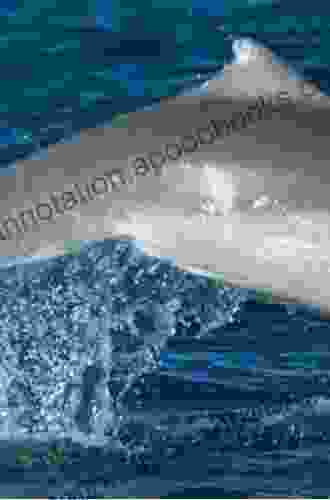Unveiling the Enigmatic Humpback Dolphins: Sousa Spp.


4.7 out of 5
| Language | : | English |
| File size | : | 34116 KB |
| Text-to-Speech | : | Enabled |
| Screen Reader | : | Supported |
| Enhanced typesetting | : | Enabled |
| Print length | : | 261 pages |
In the vast expanse of the world's oceans, there exists a captivating species of marine mammal known as the Humpback Dolphin (Sousa Spp.). These remarkable creatures, with their distinctive humped dorsal fins and playful demeanor, have intrigued scientists and marine enthusiasts alike.
Physical Characteristics and Distinctive Features
Humpback Dolphins are medium-sized dolphins, typically measuring between 6 and 9 feet in length and weighing up to 200 pounds. Their most striking feature is their prominent humped dorsal fin, located about two-thirds of the way down their backs. This hump is unique among dolphin species and serves as a distinguishing characteristic.
These dolphins have a robust build with a dark gray or black back and lighter gray or white underbelly. Their flippers are long and pointed, and their tail flukes are broad and triangular. Their faces are characterized by a short beak and a prominent melon, which aids in echolocation.
Habitat Preferences and Geographic Distribution
Humpback Dolphins are found in tropical and subtropical waters around the world, with two recognized subspecies: the Atlantic Humpback Dolphin (Sousa teuszii) and the Indo-Pacific Humpback Dolphin (Sousa chinensis).
The Atlantic Humpback Dolphin inhabits the coastal waters of West Africa, from Senegal to Angola. The Indo-Pacific Humpback Dolphin, on the other hand, has a wider distribution, ranging from the eastern coast of Africa to the Red Sea, the Arabian Sea, the Bay of Bengal, and Southeast Asia.
These dolphins prefer shallow waters close to the shore, including estuaries, bays, and river mouths. They are often found in areas with abundant fish and other marine life.
Social Dynamics and Behavior
Humpback Dolphins are highly social animals that live in groups of up to 100 individuals. They are known for their playful and acrobatic behavior, often leaping out of the water and engaging in aerial displays.
These dolphins have complex social structures with strong bonds between individuals. They communicate through a variety of vocalizations, including whistles, clicks, and pulsed calls. Humpback Dolphins also engage in social behaviors such as rubbing, touching, and tail slapping.
Feeding Ecology and Diet
Humpback Dolphins are opportunistic feeders that primarily consume fish, squid, and crustaceans. They use their echolocation abilities to locate prey, emitting high-frequency sounds and interpreting the echoes to create a mental map of their surroundings.
These dolphins are known to be cooperative hunters, working together to herd fish into shallow waters or trap them against the shore. They also engage in scavenging and are sometimes observed feeding alongside other marine predators.
Conservation Status and Threats
Humpback Dolphins face numerous threats to their survival, including habitat loss, pollution, bycatch in fishing nets, and hunting. Coastal development, dredging, and pollution from industrial and agricultural activities can degrade their habitats and reduce their food sources.
These dolphins are also vulnerable to entanglement in fishing gear, particularly gillnets and trawls. Bycatch can lead to injury, drowning, or starvation. Additionally, hunting for meat or oil has historically threatened Humpback Dolphin populations.
Conservation efforts are underway to protect Humpback Dolphins and their habitats. These efforts include establishing marine protected areas, implementing sustainable fishing practices, and raising awareness about the importance of these remarkable creatures.
Humpback Dolphins are captivating and enigmatic marine mammals that play a vital role in marine ecosystems. Their unique appearance, playful behavior, and social complexity have earned them a special place in the hearts of marine enthusiasts and scientists alike.
As we continue to explore and understand these extraordinary creatures, it is crucial to prioritize their conservation and ensure their well-being for generations to come. By protecting their habitats, reducing threats, and fostering a greater appreciation for their significance, we can safeguard the future of Humpback Dolphins and preserve the wonders of the marine world.
4.7 out of 5
| Language | : | English |
| File size | : | 34116 KB |
| Text-to-Speech | : | Enabled |
| Screen Reader | : | Supported |
| Enhanced typesetting | : | Enabled |
| Print length | : | 261 pages |
Do you want to contribute by writing guest posts on this blog?
Please contact us and send us a resume of previous articles that you have written.
 Book
Book Novel
Novel Page
Page Chapter
Chapter Text
Text Story
Story Genre
Genre Reader
Reader Library
Library Paperback
Paperback E-book
E-book Magazine
Magazine Newspaper
Newspaper Paragraph
Paragraph Sentence
Sentence Bookmark
Bookmark Shelf
Shelf Glossary
Glossary Bibliography
Bibliography Foreword
Foreword Preface
Preface Synopsis
Synopsis Annotation
Annotation Footnote
Footnote Manuscript
Manuscript Scroll
Scroll Codex
Codex Tome
Tome Bestseller
Bestseller Classics
Classics Library card
Library card Narrative
Narrative Biography
Biography Autobiography
Autobiography Memoir
Memoir Reference
Reference Encyclopedia
Encyclopedia Chitra Sankaran
Chitra Sankaran Christine Perry
Christine Perry Josephine Ruby
Josephine Ruby Hazem Kandil
Hazem Kandil Christopher Lazarski
Christopher Lazarski Josie Mendelsohn
Josie Mendelsohn Chef Taylor
Chef Taylor Teri Wilson
Teri Wilson Crystal Warakomski
Crystal Warakomski Ruqaya Izzidien
Ruqaya Izzidien Tom Sharpe
Tom Sharpe Margaret Meloni
Margaret Meloni Danna G Hallmark
Danna G Hallmark Mellinee Lesley
Mellinee Lesley Jess Ryder
Jess Ryder Daniel J Levitin
Daniel J Levitin Christine Kersey
Christine Kersey Debbie Rix
Debbie Rix Lucinda Segneri
Lucinda Segneri Christopher Andrew
Christopher Andrew
Light bulbAdvertise smarter! Our strategic ad space ensures maximum exposure. Reserve your spot today!
 Kurt VonnegutFollow ·8.9k
Kurt VonnegutFollow ·8.9k Dean CoxFollow ·4.9k
Dean CoxFollow ·4.9k Jake CarterFollow ·5.7k
Jake CarterFollow ·5.7k Eric HayesFollow ·14.8k
Eric HayesFollow ·14.8k Harvey HughesFollow ·3.6k
Harvey HughesFollow ·3.6k Henry David ThoreauFollow ·3.2k
Henry David ThoreauFollow ·3.2k Colt SimmonsFollow ·2.4k
Colt SimmonsFollow ·2.4k Paulo CoelhoFollow ·11.5k
Paulo CoelhoFollow ·11.5k

 Kevin Turner
Kevin TurnerDive into the Enchanting World of "Crazy Like Fox": A...
Prepare yourself for a literary adventure...

 Ralph Waldo Emerson
Ralph Waldo EmersonUnlock the Elegance of Daffodil Lace: An Immersive Guide...
: A Tapestry of Delicate...

 Gerald Parker
Gerald ParkerNever Lose An Argument Again: 20 Powerful Techniques From...
Are you tired of losing...

 Xavier Bell
Xavier BellSeven Animal Insertions Filet Crochet Pattern: Embark on...
Welcome to the captivating...

 Eugene Powell
Eugene PowellMagomago in TDS Magomago 12: An Unforgettable Adventure...
Step into the Enchanting World of...

 Marvin Hayes
Marvin HayesSoft Felting Needle Holder Excellence In Reborn Artistry
Unveiling the Secrets of the...
4.7 out of 5
| Language | : | English |
| File size | : | 34116 KB |
| Text-to-Speech | : | Enabled |
| Screen Reader | : | Supported |
| Enhanced typesetting | : | Enabled |
| Print length | : | 261 pages |












